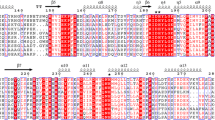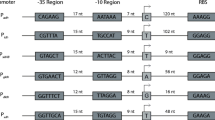Abstract
We have cloned an ORF ofBacillus thuringiensis M15, which encodes a protein sharing high similarity with D-glucose dehydrogenase. A high-expression plasmid (pBtGDH) for the ORF was constructed.Escherichia coli JM 109 transformed with pBtGDH exhibited D-glucose dehydrogenase activity, and the enzyme was purified by 3 chromatographic steps to homogeneity with 6.9 fold and a final yield of 13%. The purified enzyme has highly narrow substrate specificity for glucose and 2-deoxy-D-glucose and showed no activity with any other sugars we tested. The properties of the purified enzyme were similar to those of the D-glucose dehydrogenase (BtGDH) that is mainly produced inB. thuringiensis M15. These results show that the cloned gene encodes BtGDH, as we previously reported. This is the first report to determine the sequence of the enzyme with narrow substrate specificity. BtGDH shows 89% sequence similarity with D-glucose dehydrogenase fromBacillus megaterium IWG3 (GDH-IWG3), which has broad substrate specificity. A comparative analysis between BtGDH and GDH-IWG3 will reveal the differences between them and show the narrow specific activity of BtGDH.
Similar content being viewed by others
References
Baik S.H., Michel F., Aghajari N., Haser R., Harayama S. (2005). Cooperative effect of two surface amino acid mutations (Q252L and E170K) in glucose dehydrogenase fromBacillus megaterium IWG3 on stabilization of its oligomeric state.Appl. Environ. Microbiol., 71 (6): 3285–3293.
Boontim N., Yoshimune K., Lumyong S., Moriguchi M. (2004a). Production of D-glucose dehydrogenase for the determination of D-glucose. Ann. Microbiol., 54 (1): 87–93.
Boontim N., Yoshimune K., Lumyong S., Moriguchi M. (2004b). Purification and characterization of D-glucose dehydrogenase fromBacillus thuringiensis M15. Ann. Microbiol., 54 (4): 481–492.
Cleton-Jansen A.M., Goosen N., Wenzel T.J., van de Putte P. (1988) Cloning of the gene encoding quinoprotein glucose dehydrogenase fromAcinetobacter calcoaceticus: Evidence for the presence of a second enzyme. J. Bacteriol., 170 (5): 2121–2125.
Cozier G.E., Anthony C. (1995). Structure of the quinoprotein glucose dehydrogenase ofEscherichia coli modeled on that of methanol dehydrogenase fromMethylobacterium extorquens. Biochem. J., 312: 679–685.
Laemmli U.K. (1970). Cleavage of structural proteins during the assembly of the head of bacteriophage T4. Nature, 227: 680–685.
Lowry O.H., Rosebrough N.J., Farr A.L., Randall R.J. (1951). Protein measurement with Folin phenol reagent. J. Biol. Chem., 193: 265–275.
Makino Y., Negoro S., Urabe I., Okada H. (1989). Stability-increasing mutants of glucose dehydrogenase fromBacillus megaterium IWG3. J. Biol. Chem., 264 (11): 6381–6385.
Mehmet S., Quan G., Thomas S., Goldsmith D. (2001). Important causes of hypoglycemia in patients with diabetes on peritoneal dialysis. Diabet. Med., 18 (8): 679–682.
Mitamura T., Urabe I., Okada H. (1989). Enzymatic properties of isoenzymes and variants of glucose dehydrogenase from Bacillus megaterium. Eur. J. Biochem., 186 (1–2): 389–393.
Sambrook J., Fritsch E.F., Maniatis T., Eds. (1989). Molecular Cloning, A Laboratory Manual, 2nd edn., Cold Spring Harbor Laboratory, Cold Spring Harbor, NY.
Siebers B., Wendisch V.F., Hensel R. (1997). Carbohydrate metabolism inThermoproteus tenax: In vivo utilization of the nonphosphorylative Entner-Doudoroff pathway and characterization of its first enzyme, glucose dehydrogenase. Arch. Microbiol., 168 (2): 120–127.
Smith L.D., Budgen N., Bungard S.J., Danson M.J., Hough D.W. (1989). Purification and characterization of glucose dehydrogenase from the thermoacidophilic archaebacteriumThermoplasma acidophilum. Biochem. J., 261 (3): 973–977.
Strecker H.J., Korkes S. (1952). Glucose dehydrogenase. J. Biol. Chem., 196 (2): 769–784.
Tang Z., Louie R.E., Lee J.H., Lee D.M., Miller E.E., Kost G.J. (2001). Oxygen effects on glucose meter measurements with glucose dehydrogenase and oxidase base test strips for pointofcare testing. Crit. Care Med., 29 (5): 1062–1070.
Yamamoto K., Kurisu G., Kusunoki M., Tabata S., Urabe I., Osaki S. (2001). Crystal structure of glucose dehydrogenase fromBacillus megaterium IWG3 at 1.7 A resolution. J. Biochem. 129 (2): 303–312.
Yoshida H., Kojima K., Witarto A.B., Sode K. (1999). Engineering a chimeric pyrroloquinoline quinine glucose dehydrogenase: Improvement of EDTA tolerance, thermal stability, and substrate specificity. Protein Eng. 12 (1): 63–70.
Author information
Authors and Affiliations
Corresponding author
Rights and permissions
About this article
Cite this article
Boontim, N., Yoshimune, K., Lumyong, S. et al. Cloning of D-glucose dehydrogenase with a narrow substrate specificity fromBacillus thuringiensis M15. Ann. Microbiol. 56, 237–240 (2006). https://doi.org/10.1007/BF03175011
Received:
Issue Date:
DOI: https://doi.org/10.1007/BF03175011




